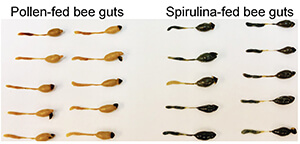
Do you eat spirulina as a nutritional supplement? If not, there’s a good chance you’ve eaten fish, eggs, chicken or beef that was fed spirulina. Why? Because spirulina (i.e., the microalga Arthrospira platensis) is packed with nutrients and relatively easy and cheap to produce.
So, if spirulina is so great, why isn’t it used as a nutritional supplement for honey bees? Beekeepers often complain that pollen substitutes aren’t as nutritious as real pollen. Is spirulina more nutritious than existing pollen substitutes, which are made from soy, yeast, egg, wheat or lentils? And what happens when bees eat spirulina? Does it actually lead to healthier bees? These are the topics for our thirty-second “Notes from the Lab,” where we highlight “Nutritional and prebiotic efficacy of the microalga Arthrospira platensis (spirulina) in honey bees,” written by Vincent Ricigliano and Michael Simone-Finstrom and published in Apidologie [2020].
For their study, Ricigliano and Simone-Finstrom first compared the types of nutrients that are found in dry spirulina powder (commercially sourced), fresh spirulina (grown fresh in the lab), a common pollen substitute (commercially sourced), and real polyfloral pollen (collected using pollen traps at a USDA ARS apiary in Baton Rouge and immediately frozen). The authors analyzed the amino acid content of each diet (amino acids are the building blocks of proteins) and the lipid profile of spirulina (i.e., all the different types of lipids and sterols).
Next, small cages of newly-emerged workers (50 bees/cage) were used to test how well honey bees consumed the dry or fresh spirulina compared to pollen substitute or real pollen. In addition, the authors tested how the bees responded to each diet via several health metrics. Specifically, to see if they gained weight (and what type of weight they gained), Ricigliano and Simone-Finstrom measured thorax weight, head protein and fat body mass after the bees had consumed the diets for 5 or 10 days.
To assess nutritional status, the authors measured vitellogenin expression and gut bacteria abundance. Vitellogenin is a lipoprotein produced in fat body cells that’s often used as a biomarker of diet quality and nutritional status. Gut bacteria abundance was assessed to evaluate how spirulina may act as a “prebiotic” nutrient source (i.e., a nutrient source that could potentially promote beneficial gut microbiota in the bees). As we all know nowadays, a healthy gut microbiota is critical for all animals, including honey bees.
So, what did they find? Did the dry or fresh spirulina contain good nutrients compared to the artificial pollen or real pollen? Yes and yes. In fact, as can be seen in Figure 1, both dry and fresh spirulina nearly always had higher amino acid concentrations compared to real pollen (compare the green bars to the orange bars in Figure 1). Interesting! This included all the essential amino acids (i.e., the amino acids that bees can’t make on their own and therefore must have in their diet) with the exception of histidine and lysine.
When compared to the pollen substitute, both dry and fresh spirulina always had higher amino acid concentrations (compare the green bars to the yellow bars in Figure 1). Finally, for those of you who are wary about growing your own spirulina, you’ll be happy to see there was very little difference in amino acids between the dry spirulina powder (i.e., spirulina that was bought at a store) and fresh spirulina (i.e., spirulina that was grown fresh in the lab).
What about consumption? Did the bees actually consume the spirulina? Yes. And before you start thinking this is weird, remember that spirulina is a plant, and pollen comes from … plants. Pollen is packed with proteins and lipids, and so is spirulina. So, perhaps it shouldn’t be surprising that bees will readily eat spirulina.
More specifically, in two different tests, the bees consumed almost as much spirulina as pollen substitute or real pollen. Not quite as much — about 10-25% less after 10 days compared to real pollen, and about 5-10% less after 10 days compared to pollen substitute. This slightly lower consumption of spirulina is actually quite interesting given the next results.
Did the bees gain weight when fed spirulina? Yes. Even though they ate 10-25% less spirulina compared to real pollen, the bees gained just as much weight (dried thorax weight shown in Figure 2, panel a) and had just as much protein in their heads (soluble head protein content shown in Figure 2, panel b) compared to ….


